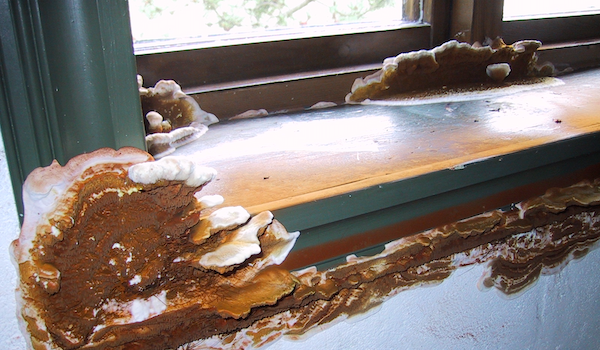
Occurrence
Dry rot can occur anywhere in the building in connection with masonry, woodwork, concrete, flashings, insulation, etc. Infestations of dry rot typically occur in connection with leaks in roofing, worn gutters and roof drains, leaking wells and ground moisture penetration.
Once the house fungus has started, it can use its special string mycelium to collect and transport water over large distances and thereby moisten new parts of the structure. This allows it to continue its growth and eventually spread from basement to attic. True House Fungus can spread far into the hidden parts of the building, e.g. behind panels, in the cavity wall, in the joints in the masonry, behind the masonry floor joists, etc. before the infestation is discovered. True Mould produces oxalic acid to break down the hemicellulose hard coat of the wood cells, allowing it access to the cellulose fibers. To regulate the acid balance, the fungus needs lime from grout, bricks, plaster or mineral wool, even polyurethane foam.
The True House Fungus prefers stagnant moist air, a wood moisture content of between 20-30 % and a temperature below about 25°C. Growth stops when the temperature rises above 25°C and the fungus dies when the temperature passes 37°C. However, it can grow even at freezing temperatures.
Under optimal conditions, true dry rot is a very aggressive wood-degrading fungus. While other wood-degrading fungi can take many years to decompose the wood, True House Fungus attacks often result in total degradation of the affected wood within a few months, even in heavily dimensioned wood.

Fruit body
Fruiting bodies from True House Fungus are frequently seen in infestations in buildings. When the fruiting bodies are seen, the infestation is usually well advanced. Although the infestation is found in dark structures, the mycelium seeks light where the fruiting body is formed - for example, at a basement window, on steps, a skirting board or around a fluorescent lamp. The fruiting body is often shaped like a flat disk, orange or cocoa brown in the middle and with a thickened white rim around it. In some cases, cone-shaped formations are also seen. The brownish color is due to the millions of spores that the house fungus produces to reproduce. Therefore, brown to orange-brown dusty deposits are often seen around skirting boards, panels etc. deposited by a fruiting body somewhere in the structure.

Mycelium
Fresh infestations are characterized by the development of a waxy, snow-white mycelium, often with lemon-yellow water droplets. As the mycelium ages, the color changes to greyish. Thicker strands gradually form. In well-developed house fungus infestations, meter-long, pencil-like strands are often seen. Characteristic of the string mycelium is that when it dries out it becomes stiff and hard and can be broken with a snap. String mycelia from other wood-degrading fungi do not have this property.
Sometimes, instead of string mycelium, a grayish, parchment-like mycelium is seen that can be pulled off the wood or masonry in flakes. This surface mycelium is typically seen on the underside of floorboards, panel backs, etc.

Degradation
During decomposition, the wood loses most of its weight and cracks across the fiber direction (brown mold, see page 5), resulting in 5-10 cm crack blocks, often mixed with greyish mycelium and strands. Both the sapwood and the core decompose.

Fighting with ProtoxSvamp
Live mycelium from True House Fungus can transport water to a dry area of the building, wetting the wood and then attacking and degrading it.
It is therefore very important to determine the full extent of the damage before you can start the actual fight against the infestation. If an area with a True House Fungus infestation in the building is overlooked, the entire repair may end up being wasted. It is therefore necessary to systematically investigate the extent of the infestation and develop a treatment plan based on this. To ensure that all mycelium is controlled, a safety zone of 1 meter is included. It is recommended to contact a consultancy company specializing in determining the extent of True House Fungus.
